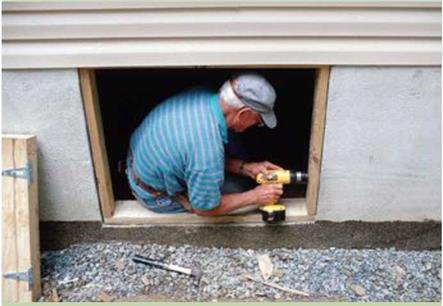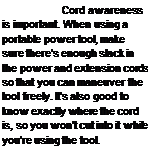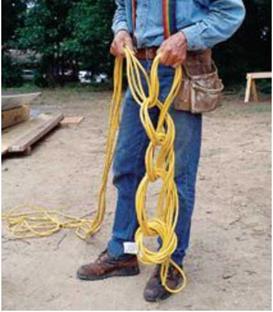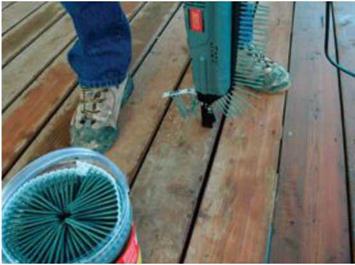USING DRILLS
Old drills were made with enclosed trigger guards like those on firearms. Carpenters had their trigger fingers caught and broken from time to time, such as when a drill bit got hung up on a knot in a board and spun suddenly. For safety reasons, workers often used a hacksaw to cut out the trigger guards. These days, manufacturers have eliminated trigger guards, but that doesn’t mean drills can’t do you harm. To use a drill safely, follow these guidelines:
■ Use clean, sharp bits.
■ Don’t force the drill; let it cut at its own pace.
■ Use a slower speed when drilling harder materials, and coat the bit with wax or silicone to reduce resistance.
■ When drilling thick material, hold the drill with both hands, and use the side handle if the drill comes with one.
■ If you’re drilling a deep hole, pull the bit out of the hole from time to time to clear debris from the bit and the hole.
■ Don’t rely on hand pressure alone to hold the workpiece in which you’re drilling. Instead, clamp the workpiece to a sawhorse or a workbench.
■ Be especially careful when drilling from a ladder. Make sure you have proper balance.
■ ![USING DRILLS Подпись: New, lightweight tablesaws can be brought to the job site with ease. [Photo by Don Charles Blom]](/img/1312/image114_1.gif)
 Release the trigger immediately if the bit begins to bind or catch.
Release the trigger immediately if the bit begins to bind or catch.
|


![USING DRILLS Подпись: Many of today's tools are powered by compressed air. Lightweight compressors are easy to move around a job site. [Photo by Don Charles Blom]](/img/1312/image119_0.gif)
![USING DRILLS Подпись: Tool kits, nail bags, and pockets for buckets are available to help keep tools handy and in order. [Photo by Don Charles Blom]](/img/1312/image120_0.gif)
Whether corded or cordless, a drill is usually described by the maximum capacity of its chuck (bit holder). A 3/s-in. model can handle a bit shank diameter of up to 3/s in. For general carpentry work, buy either a 3/s-in. or a /Tin. drill. Look for a model with a reverse switch (so you can remove screws) and variable speed control.
A good cordless drill will also have a clutch, which makes it easier to drive screws of different sizes. A low clutch setting (1 to 3) is good for driving small screws. Higher settings are used for bigger screws.
For almost sixty years I have been using an air compressor to power the various pneumatic tools used on a job site. The early models took a team of mules to haul around, but many of the compressors we have today can be carried with one arm or have been put on wheels to make maneuvering easier. With the proliferation of air-driven tools, a good air compressor, along with an air hose or two, is a valuable asset. Just make sure workers are given basic safety training and guidelines to avoid injury (see Resources on p. 279).
When it comes to tools, work clothes, or tool kits, one size fits all is a thing of the past. These days there are numerous companies (see Resources on p. 279) that offer a good line of work accessories that are tailored for both men and women.
Power tools need adequate power to operate properly, and that means you need good-quality extension cords. The smaller the gauge number marked on the cord, the heavier the wire. The three most common gauges are 12, 14, and 16 (12 is the heaviest). From time to time, I’ve seen carpenters run a circular saw with a 100-ft. 16-gauge extension cord. That’s like watering a lawn with a hose the diameter of a drinking straw. Not much water (or, in the case of an extension cord, electricity) comes through. With
a light extension cord, you risk burning out the motor. To prevent that, always use the shortest cord that will do the job. There’s no need to use a 50-ft. cord if you are working just 15 ft. from an outlet. Here’s a rule you can use for selecting the proper extension cord: Use 16-gauge wire for a 25-ft. (or shorter) cord, 14-gauge wire for a 50-ft. cord, and 12-gauge wire for a 100-ft. cord.
Nominal versus actual size.




 |
When you shop for lumber, remember the difference between nominal and actual measurements. If you buy a 2×4, you’ll get a IJ/2-in. by 3f2-in. board. If you buy a 2×6, you’ll get a l/^-in. by 5//2-in. board.







Leave a reply